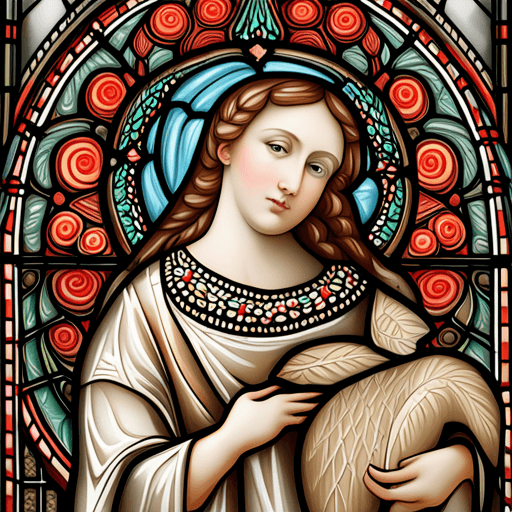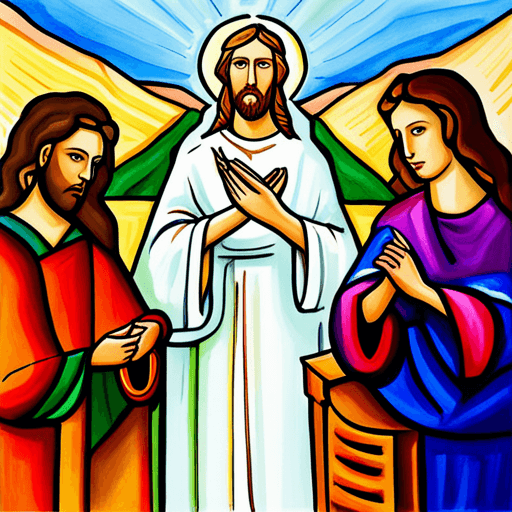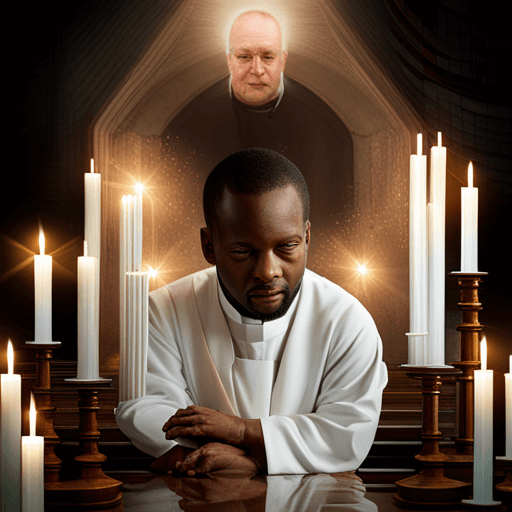Are you looking for a way to deepen your connection with the Catholic faith and feel more connected to the community of saints? Look no further than the litany of saints. This holy tradition, dating back centuries, is a powerful tool for prayer and meditation that can help bring you closer to God and the many inspiring figures who have come before us.
In this comprehensive guide, we will explore the history and origins of the litany of saints, examining its structure and format as well as the various categories of saints included in this powerful prayer. We will also delve into its significance in Catholic theology, discussing how it has been used throughout history to inspire devotion and strengthen spiritual bonds.
Whether you are new to the Catholic faith or a lifelong follower looking for new ways to deepen your connection with God, this guide is an essential resource that can help you discover all that the litany of saints has to offer.
History and Origins of the Litany of Saints
Discover the fascinating backstory behind the beloved prayer that’s been recited by countless believers for centuries.
The Litany of Saints is a liturgical prayer that dates back to the early days of Christianity and has become an important part of Catholic tradition. It was originally used during processions, ordinations, and other special occasions in the Church.
Over time, the Litany evolved to include many different saints and became a way for believers to seek intercession from these holy figures.
Its influence on liturgical music is also significant as it has inspired many composers throughout history to set it to music.
Today, variations of the Litany can be found in different cultures around the world, highlighting its universal appeal and importance within Catholicism.
Structure and Format of the Litany
Let’s take a closer look at how the structure and format of the Litany of Saints can enhance our spiritual experience.
The litany is divided into different parts, with each section focusing on a particular group of saints or aspects of faith. This structured approach helps us to connect with specific saints who we feel drawn to or need guidance from.
The chanting techniques and tips used during recitation also add to the power of this prayer. Chanting creates a rhythm that helps focus our minds and hearts on the words being spoken. When done in a group setting, it creates an even stronger sense of unity among believers.
By following the structure and format while utilizing chanting techniques, we can truly tap into the spiritual power of the Litany of Saints.
Categories of Saints Included in the Litany
Get ready to feel inspired as you explore the diverse range of heavenly advocates featured in the Litany of Saints. This powerful prayer includes categories such as Martyrs and Doctors, who are recognized for their intercessory power.
The Martyrs, those who have given their lives for their faith, are seen as particularly effective intercessors because they have already made the ultimate sacrifice. They understand what it means to suffer for one’s beliefs and can empathize with our own struggles.
The Doctors of the Church are also included in the Litany, and they’re recognized for their intellectual contributions to the faith. These saints were theologians, philosophers, or writers whose writings have helped shape Catholic doctrine throughout history. Their intellectual rigor and deep understanding of scripture make them valuable intercessors when we seek guidance or wisdom in our own spiritual lives.
By including these diverse categories of saints in the Litany, this prayer reminds us that no matter what our needs may be, there’s a saint who has walked a similar path and is ready to lend us their intercessory power.
Significance of the Litany in Catholic Theology
The Litany of Saints holds great importance in Catholic theology, serving as a powerful tool for seeking intercessory help from a diverse range of heavenly advocates. This prayer is recited during various liturgical celebrations, such as the Easter Vigil and ordinations.
The litany includes the names of numerous saints, martyrs, apostles, and angels, each with their unique symbolism and significance. The Litany also serves as a reminder of the communion between the faithful on Earth and those who have gone before us into eternal life.
By invoking these holy men and women, we acknowledge their exemplary lives and seek their assistance in our own spiritual journey. The Litany reinforces our belief in the communion of saints and reminds us that we are not alone in our faith.
In this way, it offers hope to those struggling with doubts or feeling disconnected from their faith community.
Using the Litany in Personal Prayer and Meditation
You can deepen your personal prayer and meditation by incorporating the powerful intercessory help of heavenly advocates, reminding yourself of the communion between you and those who have gone before you into eternal life.
One practical tip for using the Litany in your daily prayer is to choose a few saints that resonate with you personally, based on their life stories or patronages. You can then recite their names during the Litany and ask for their intercession in specific areas of your life.
For example, if you struggle with anxiety, you might ask for St. Dymphna’s help; if you are discerning a vocation, you might turn to St. Therese of Lisieux.
The benefits of incorporating this tradition into your prayer life are manifold. Not only does it connect you more deeply to the larger community of faith throughout history, but it also reminds us that we are never alone in our struggles or joys. We have an entire army of saints cheering us on and ready to assist us at any moment.
Additionally, the act of invoking these holy men and women helps cultivate a greater sense of humility within ourselves as we recognize our own limitations and need for divine assistance.
Frequently Asked Questions
Are there any specific prayers or devotions that are traditionally said before or after reciting the Litany of Saints?
Before and after reciting the Litany of Saints, it’s common to say preparatory prayers and post-litany devotions. Some popular preparatory prayers include the Sign of the Cross, an Act of Contrition, and a prayer asking for guidance from the Holy Spirit.
After finishing the litany, many people like to offer a prayer of thanksgiving or a petition for intercession from specific saints mentioned in the litany. Some also choose to meditate on certain aspects of their faith or spend time in quiet reflection.
Whatever your personal preference may be, incorporating preparatory prayers and post-litany devotions can deepen your connection to this holy tradition and help you feel more connected to your faith community.
What is the history behind the use of incense during the recitation of the Litany of Saints?
During the recitation of the litany of saints, you may have noticed the use of incense. The burning of incense has a long history in religious ceremonies and is often used to symbolize purification, sanctification, and spiritual elevation.
In the context of the litany of saints, the use of incense can be seen as a way to elevate our prayers to God and to honor the saints who we’re calling upon for their intercession. It can also serve as a physical representation of our desire for holiness and purification before God.
Overall, the use of incense adds an extra layer of symbolic significance to this already powerful prayer tradition.
How has the Litany of Saints evolved and changed over time?
As you explore the Litany of Saints, you’ll discover that it has evolved and changed over time. This evolution has been influenced by cultural and regional traditions, resulting in a diverse range of versions throughout history.
As different cultures adopted Christianity and began to incorporate their own practices into the litany, new saints were added or removed, and variations in language and style emerged.
Despite these changes, the core purpose of the litany remains the same: to honor and invoke the intercession of all saints. By understanding its evolution and changes over time, you can gain a deeper appreciation for this holy tradition and your place within it.
Can the Litany of Saints be adapted or customized for specific occasions or intentions?
You may wonder if the litany of saints can be customized or adapted for specific occasions or intentions. The answer is yes!
Customizing the litany allows you to make it more personal and relevant to your current needs. For example, you can add specific saints who are relevant to a particular occasion or intention, such as adding St. Anthony for lost items or St. Jude for hopeless cases. You can also modify the language used in the litany to fit better with your desired tone or style.
However, it’s important to remember that while customization is possible, the core structure and purpose of the litany should remain intact.
Are there any particular saints or groups of saints that are especially invoked in the Litany for specific purposes or needs?
Looking for guidance with your unique devotions? Look no further than the patron saints invoked in the litany.
Each saint has their own special area of expertise, from St. Anthony for lost items to St. Jude for impossible situations. By invoking these saints, you join a community of believers who’ve found solace and strength in their intercession.
Allow yourself to be drawn into this tradition and find comfort in the knowledge that you’re not alone in your struggles.
Conclusion
Congratulations! You’ve just completed a comprehensive guide to the holy tradition of the Litany of Saints.
By delving into its history and origins, you’ve gained a deeper appreciation for this powerful prayer that’s been recited by generations of Catholics around the world.
As you learned about the structure and format of the Litany, as well as the categories of saints included in it, you’ve gained insight into how this prayer can be used to bring comfort and inspiration to your personal spiritual practice.
And finally, by exploring its significance in Catholic theology, you now understand why this venerable prayer continues to be an essential part of religious life.
So go ahead and incorporate the Litany into your daily meditation and prayer routine – may it inspire and uplift you on your spiritual journey!




